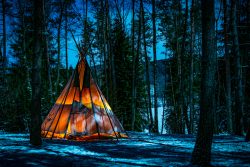How Do Teepees Keep Rain Out?
August 1, 2023 4:18 pm Leave your thoughts
1. Shape and Design:
The conical shape of a teepee is no accident; it is specifically engineered to withstand the elements, including rain. The absence of any flat or horizontal surfaces ensures that rainwater is not able to collect and seep through. Instead, rain simply runs down the sloping surface of the teepee, preventing any leakage.
2. Waterproof Outer Covering:
The outer covering of a teepee plays a vital role in keeping rain out. Traditionally, Native Americans used animal hides, such as buffalo or elk hides, to create a durable and weather-resistant covering. These hides were skillfully tanned and treated to repel water. The overlapping panels were meticulously sewn together, forming a solid barrier against rain.
3. Smoke Flaps:
One of the most unique features of a teepee is the smoke flaps located at the top. These flaps not only allow for ventilation and smoke removal but also serve as an additional rain protection mechanism. When closed, the smoke flaps prevent rain from entering the teepee through the openings at the top. However, during fair weather, the flaps can be adjusted to allow for improved air circulation.
4. Interior Liner:
Inside the teepee, a fabric liner is often suspended from the framework. This liner serves multiple purposes, one of which is to further enhance the waterproof nature of the teepee. The liner acts as an additional barrier against rain, preventing any moisture that may seep through the outer covering from reaching the interior space of the teepee.
5. Proper Pitching and Maintenance:
To ensure maximum rain protection, the proper pitching and maintenance of a teepee are crucial. The teepee poles need to be placed at the correct angles and securely anchored to the ground. The outer covering should be tight and properly fastened to avoid any sagging or gaps that could let rain in. Additionally, regular maintenance, such as inspecting and repairing any tears or weak spots, is essential to maintain the teepee’s rainproof status.
Conclusion:
The teepee’s ability to keep rain out is a testament to the ingenuity and practicality of Native American design. From its carefully engineered shape to the use of waterproof coverings and clever features like smoke flaps, the teepee demonstrates how ancient cultures found innovative solutions to thrive in various climates. Even in modern times, teepees continue to be used for cultural events and recreational purposes, reminding us of the remarkable architectural wisdom of Native American tribes. So, the next time you see a teepee, take a moment to appreciate the centuries-old craftsmanship that keeps rain at bay and marvel at the beauty of their design.
Got Questions? Let Us Help!
Categorised in: Teepee Tips
This post was written by admin
